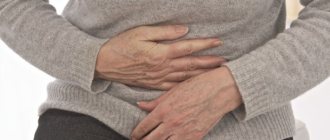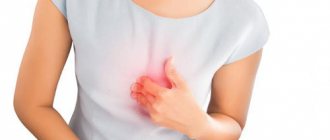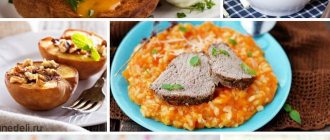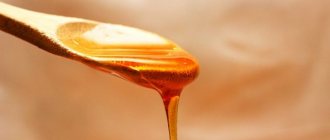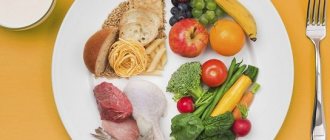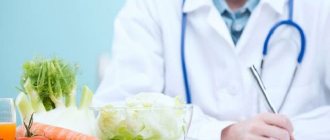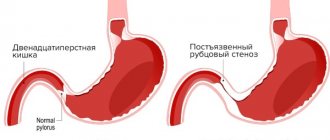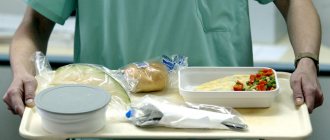Diet for intestinal obstruction
Diet, when intestinal obstruction is determined by the course of the disease itself, the type of obstruction, it will be acute,
partial, or chronic, complete and the patient’s condition.
Before and after such an operation, different diets are prescribed.
The diet that is prescribed after the operation is that for the very first 10-12 hours the patient is not even allowed to drink, much less eat.
A special probe is carefully inserted into the patient's nasal cavity, which removes all contents from the stomach at certain intervals. After surgery, parenteral nutrition is preferable, that is, nutrition bypassing the gastrointestinal tract. This is achieved by administering to the patient everything he needs by drip, intravenous injection, or through the rectum. After three to five days, you can begin introducing some nutrients through a tube and into your stomach. If the patient's condition is normal, then the probe is removed and the patient takes liquid food on his own.
A good choice here is fermented milk products or nutritional mixtures, which need to be used fractionally, little by little, but often. And a few days after the operation, in strict accordance with the doctor’s plan, they switch to diet number zero, specially designed to be as gentle as possible on the stomach and intestines. This patient’s diet includes only liquid and easy-to-digest foods; salt is completely limited. Eating is done in too small portions, frequently, up to six or seven times a day.
Gradually, observing the condition of our patient, he is smoothly transferred to diet number 4, especially for those patients who have undergone difficult surgery on the intestines. Diet 4 is as gentle as possible on the intestines, both mechanically and chemically, and prevents the occurrence of fermentative processes in the intestines. The diet is characterized by a limitation in the patient’s daily diet of carbohydrates and fats, fiber, hot and spicy, salty and, of course, smoked foods. All food is prepared exclusively by steaming, or boiling and pureed.
Expanding this diet, the patient is transferred to a new one - 4 V. The same diet already provides complete nutrition, while remaining gentle on the intestines. The food diet becomes much more varied and wider, so only pureed food is abandoned and it is given whole. All dishes are steamed. Only after a few weeks, or even months, depending on the patient’s state of health, they are allowed to smoothly switch to an expanded, but still, diet, and everything fried and fatty, spicy, and smoked is excluded from it.
Features of a lipid-lowering diet
The purpose of this nutritional system is to stabilize weight, reduce the amount of cholesterol in the blood and improve the functioning of the digestive system.
A lipid-lowering diet helps normalize the activity of the gastrointestinal tract and reduce body weight
Features of a lipid-lowering diet:
- fractional meals, 5 to 6 times a day in small portions;
- drinking at least 2 liters of still water every day;
- emphasis on representatives of the cereal and fruit and berry families with a high fiber content, at least 400 grams per day;
- reducing the amount of animal fat consumed;
- the main source of protein is poultry, cottage cheese and low-fat fish;
- moderate use of dairy products;
- the number of yolks is 3 pieces for 7 days;
- It is advisable to steam meat products;
- inclusion of seaweed and seafood in the diet;
- The permissible daily amount of bread is 200 grams, which is equal to 2 medium pieces.
Laminaria (sea kale)
You need to have dinner a few hours before going to bed, giving preference to protein dishes.
Table 6. List of recommended and prohibited products
| Can | It is forbidden |
| dill, basil and parsley; sea fish, including the salmon family; seaweed; vegetable oil; garlic; oatmeal; dried fruits; compotes and juices prepared without the use of sugar; vegetables, fruits and berries with peel. | dairy products with a fat content of more than 5%; any offal; chocolate; caviar; fatty meat and smoked meats; red poultry meat; sugar; cocoa; margarine and other fats, including lard; fatty meat broths; sturgeon; carbonated drinks; bread made from first-class flour; confectionery and baked goods; coffee; honey; alcohol and beer. |
A lipid-lowering diet should be followed for at least 2 months
Approximate diet for 3 days
It is allowed to swap the indicated dishes and skip intermediate meals. It is also possible to replace products with analog ones with the same calorie content.
Day 1:
- Breakfast - cheesecakes and 1 glass of freshly squeezed juice.
- Second breakfast - fruit salad of persimmons, apples and pears.
- Lunch - steamed chicken fillet and boiled rice with a vegetable side dish.
- Afternoon snack - 2 pieces of bread and 1 baked apple.
- Dinner - vegetable salad and red fish baked with lemon and basil.
Day 2:
- Breakfast - low-fat omelet and tomato salad with added herbs.
- Second breakfast - vegetable salad with apple cider vinegar.
- Lunch - potato and carrot soup in a light broth, Greek salad and 1 slice of bread.
- Afternoon snack - low-fat yogurt with jam.
- Dinner - boiled fish fillet with mashed potatoes.
Day 3:
- Breakfast - wheat porridge cooked with pumpkin.
- Second breakfast - 1 soft-boiled egg and a slice of bread.
- Lunch - steamed veal and vinaigrette.
- Afternoon snack - 2 bananas.
- Dinner - pasta with stewed chicken.
Daily 2 liters of water should be divided into 8 glasses and drunk either 30 minutes before a meal or 1 hour after a meal. If you feel hungry before going to bed, you can quench it with 1 glass of low-fat kefir, 1 carrot or small apple. If the body requires sweets, it is allowed to eat sugar-free jelly, low-calorie crackers, oatmeal cookies or dried fruits several times a week.
Dried fruits instead of sweets
Any surgical intervention is a great stress for the body. The operation is fraught with disturbances in metabolic and digestive processes, therefore in the postoperative period the patient must strictly adhere to a therapeutic diet. It will help you get enough nutrients and restore the functioning of the gastrointestinal tract.
Video - Proper nutrition after removal of an intestinal tumor
Surgical manipulations are considered radical medical methods. After intestinal surgery, the body and digestive organs need recovery. The best way to tidy up the gastrointestinal tract is to follow a specialized diet.
Postoperative period after adhesive intestinal obstruction.
Good afternoon. I would like to talk with those who have undergone surgery to remove adhesions. On the topic of how to avoid repeat surgery. I had congenital intestinal obstruction, 25 years later I had a second operation, acute adhesive intestinal obstruction. I know that after the operation new adhesions appear and there is a high probability that the operation will need to be repeated. How to avoid this? Who knows? Perhaps you already have experience or someone has statistics, what is the percentage of repeat operations among the population?
Subscribe to new comments
20 January 2010, 17:47
Hello, Yuliya_08! I also had acute adhesive obstruction for 5 months. ago. It arose after surgery on the large intestine. I am also very concerned about this issue, since I was told the same thing. The surgeon also told me that with adhesive disease you need to learn to live. That’s what I try to do: I don’t eat raw vegetables and fruits (I stick to a diet ) and be less nervous. Do you know anything to prevent a relapse?
January 21, 2010, 21:33
I know that it is imperative to follow a diet and not lift weights exceeding 6 kg. 2.5 years have passed since my operation, but I read that conclusions about the success of the operation can only be drawn after 3 years :(. I was on a strict diet for 7 months and only ate bananas from raw fruits, there were no problems. I boiled apples in in a saucepan along with slices of oranges it turned out very tasty. I also ate steamed fish, carrots, a little potatoes, bread only for hops or sowing. But the boiled beet was not very well digested, so I practically don’t eat it even now, it’s too heavy.
January 22, 2010, 6:08 pm
Yes, I also boil apples in a double boiler or bake them (without the skin), I also eat boiled pumpkin, and I don’t eat bread at all (only biscuits). Also, the doctors said that I can’t have milk, only fermented milk products. But I still have it from time to time. I have attacks (I immediately take medications that relieve spasms), I am very afraid of all this. Do you happen to know whether you can drink freshly squeezed juices or not? How are you feeling now?
January 25, 2010, 20:52
I started drinking freshly squeezed juices after a year. Although in the postoperative period I drank a little carrot and orange (heavily diluted with water). What anti-spasm medications do you take? I feel normal, if I don’t overeat and follow my diet, then everything is fine, the only thing is if I start breaking my diet, sheep feces start to bother me, if you know what this is, I immediately feel scared and I try to eat carefully. I read on the Internet there are special exercises, did doctors recommend you do any exercises?
September 2, 13:46
Be sure to take Vaseline oil every day. This is the recommendation of surgeons to my husband after another such operation.
Surgical intervention for intestinal diseases is performed for various reasons. Most often, the inflamed appendix and the strangulated loop during hernias are removed. In the small intestine, Meckel's diverticulum is resected, the causes of intestinal obstruction (adhesions, intussusception) and the consequences of mesenteric artery thrombosis are corrected.
Surgeries on the large intestine are performed much more often, since diverticulitis, polyps, tumors, Crohn's disease, and hemorrhoids are not treated with conservative methods. As a result of the disease and subsequent intervention, local blood circulation and innervation are disrupted.
The intestines lose part of the surface for the absorption of nutrients, beneficial microflora, and peristalsis suffers. The diet after surgery on the intestines allows you to support the remaining part during the restoration of functions, it is prescribed in stages.
Features of the disease
The main causes of intestinal obstruction are:
- unbalanced diet;
- exposure to toxic chemicals;
- ingestion of a foreign object;
- intussusception;
- past infectious and viral diseases;
- pathologies of the abdominal cavity: polyps, adhesions, hernias, tumors;
- the presence of stones in the gall bladder;
- reproduction of pathogenic parasites: worms, roundworms;
- volvulus;
- malignant tumors.
Intestinal disease has pronounced symptomatic signs: cramping, bursting abdominal spasms, bloating, obstruction with constipation, enlargement of the abdominal cavity, nausea, vomiting, decreased cravings for food, the appearance of blood clots from the anus after defecation. Diagnosis of obstruction is carried out during laboratory tests, radiography, irrigoscopy, ultrasound, computed tomography.
Nutrition in the first 4 days
From the moment the patient is removed from anesthesia, he is shown complete fasting for 24 hours. You are not even allowed to drink water. You can wet your lips and rinse your mouth. Parenteral nutrition preparations and glucose are administered intravenously, providing energy support for metabolism.
From the second day, a therapeutic diet is prescribed in the volume of table No. 0a. To mechanically spare the intestines, all dietary food should be of liquid consistency. Prepare a low-fat broth, a decoction of rice, oatmeal, jelly and jelly from non-acidic berries; you are allowed to drink rosehip compote. The serving size is small, but the frequency of meals is maintained up to 7–8 times a day.
Foods allowed after surgery
It is allowed to eat food that does not burden or irritate the intestines. These products include:
- cereals;
- non-acidic vegetables and fruits;
- fermented milk products;
- foods rich in animal protein;
- eggs;
- juices, compotes, decoctions;
- crackers.
Recommended and prohibited foods
Diet for 5–15 days after surgery
From the fifth day, the diet gradually expands. The patient is transferred to table No. 1a. It is also used in the treatment of peptic ulcers. All dishes remain liquid and pureed, but higher in calories (2000–2200 kcal). The frequency of feedings is reduced to six times a day. The body receives 2.5 kg of food per day. The diet contains 80 g of protein and 200 g of carbohydrates.
- liquid porridges (buckwheat and millet are excluded for now);
- milk soup;
- cereal soup with vegetable broth;
- steamed meat soufflé;
- one soft-boiled egg or steamed omelette;
- fresh grated cottage cheese with a spoon of sour cream;
- berry jelly, rosehip decoction.
Aspects of nutrition after small intestinal surgery
Surgery on the small intestine for cancer or food obstruction is performed due to increasing complications, as well as as a result of tumors within the intestinal lumen. The diet must include vegetable fats, prunes, black or white raisins, kefir or fermented baked milk. Any food should be warm - neither hot nor cold.
Note! It is recommended to pay attention to a slag-free diet in the first 5 days after the intervention. A low-carbohydrate liquid diet ensures complete tissue healing and eliminates traumatic complications after surgery.
Features of nutrition at the end of the month
By the end of the recovery period, the patient is prescribed diet No. 1. It allows for significant expansion compared to previous versions. The total food mass reaches 3–3.5 kg, calorie content 3000–3200 kcal.
The requirements for a gentle diet (mashed dishes) continue, but porridge with diluted milk (millet is excluded), kefir are introduced, chopped meat, casseroles, small vermicelli or noodles, and omelettes are allowed. You can eat pureed vegetables to a limited extent. Berry and fruit jelly are allowed.
The composition of the menu corresponds to the physiological daily norm: protein increases to 100 g, fats can be 100–110 g, carbohydrates 400–450 g. The patient is allowed:
- dried wheat bread, crackers, biscuits;
- cereal soups with non-rich meat broth;
- boiled dishes from lean meat and fish, soufflés, cutlets, meatballs;
- vegetable puree from carrots, potatoes, cauliflower, pumpkin, zucchini;
- non-acidic berries and fruits in compote, boiled in porridge, baked;
- a little honey, jam.
How long the patient will be on diet No. 1 depends on the individual characteristics of the disease and immunity. Most often it takes 2–3 weeks.
Cancerous tumors
Proper menu planning for intestinal surgery for cancer reduces the risk of relapse and postoperative complications. It is nutrition that largely restores the functionality of all parts of the intestines and stabilizes the function of the entire digestive system as a whole. There is no special diet.
The main requirement after intestinal resection is to thoroughly chew food and exclude nervous factors. Portions must be reduced to 200 ml, the number of meals increased up to 5 times. Food ingredients must contain a large amount of antioxidants and microelements.
Diet for the final stage of recovery
Nutrition after intestinal surgery must go through another restrictive period so that the body is fully functionally prepared to receive and digest solid foods. For this purpose, table No. 4c is assigned.
The basis of this option is diet No. 1; the requirements for boiling, baking or stewing all dishes remain, but the introduction of uncut food is allowed. Prohibited: salt, spicy seasonings, foods that can increase fermentation in the intestines. The meat is served in pieces or chopped. Non-acidic fruits and berries (strawberries, apples, pears, bananas) in their usual form are allowed.
- fresh baked goods;
- fatty meat and fish;
- confectionery products with cream, puff pastry;
- rich soups;
- canned food;
- legumes in any form;
- smoked meat products;
- salted vegetables, fish.
The doctor decides how long to adhere to diet table 4c depending on the course of the disease and restoration of digestion. Some patients will be forced to follow nutritional rules throughout their lives. Patients who undergo endoscopic surgery most quickly and relatively well tolerate alternating stages of diet expansion.
Removal of polyps, diverticula, small circumscribed tumors, adhesions during colonoscopy, laparoscopy is considered a low-traumatic method of intervention, so healing is faster.
What not to eat for a year after surgery
Even with good health and positive dynamics of examination data, patients should exclude from the diet for at least a year:
- puff pastry and butter dough, fresh pastries, warm bread, bread products with rye flour and bran;
- broths from fatty fish or meat, milk soup, rassolnik, okroshka, first courses with mushrooms or beans, peas;
- cooking oil, margarine, lard;
- lamb, pork with fat, duck, smoked sausages, sausages, sausages, semi-finished products, dumplings;
- all types of canned food, alcohol, carbonated drinks;
- sour, fatty dairy products, sharp cheese and cheese products with a fat content above 40%;
- sorrel, onion, spinach, garlic (you can add no more than 2 g dried to dishes);
- radishes, cucumbers, mushrooms, daikon, turnips;
- cakes, ice cream, buttercream cake;
- dates, prunes, figs, apricots and dried apricots, raisins;
- all purchased sauces, spices - pepper, mustard, horseradish;
- fresh and for juices - grapes, apricots, peaches, plums.
Features of the diet after surgical treatment of various diseases
Choosing the right menu requires an individual approach and taking into account a person’s specific disease. Having corrected the intestinal pathology, treatment should prevent a relapse and, if possible, eliminate the cause of the disease. To do this, doctors add special nutritional conditions.
After appendicitis removal
Diet 0a is maintained for the first 2 days. On the 3rd–4th day, the operated patient is transferred to option 1b, and from the fifth day - to a full-fledged table 1. Within a few days, the diet expands to the physiological norm. The serving size increases from 100 g to 300. At the same time, it is recommended to drink up to 2 liters of liquid per day.
In severe cases of the disease, complications of peritonitis, the change in stages of the surgical diet is delayed by 1–2 days. The attending physician determines the indications individually. After discharge from the hospital, dietary nutrition must be followed for 3 to 6 months.
After surgery to remove adhesions
If the intestinal walls are intact, it is recommended to introduce more liquid into the diet: alkaline mineral water, decoctions of herbs, rose hips, weakly brewed green tea, low-fat broths, soups. Then liquid quiches and purees are allowed. Dairy products and protein foods (meat, fish) are introduced gradually, under tolerance control.
The intestines should not swell; restored peristalsis becomes sufficient to remove toxins. All contraindications to fatty and fried foods, pickles, and legumes are supported. After surgery, the patient needs to monitor the regularity of bowel movements to prevent relapse.
After tumor removal
During the rehabilitation process, the body needs immune support. The diet pays more attention to vegetable dishes and cereals. Meat and fish are introduced later than usual, since protein nutrition is hard on a weak immune system. Vegetable oils and non-acidic fruits are useful.
During surgery for intestinal obstruction
The patient's condition is usually severe, and severe intoxication remains. Therefore, parenteral nutrition and therapeutic fasting are maintained for a longer period. Then all dietary tables are assigned one by one. Depending on the cause of the obstruction, the most suitable therapeutic diet is selected for the patient during the recovery period.
After rectal surgery
In order to spare the intervention site, they try to give the patient less vegetable dishes with plant fiber. This helps to hold the stool a little and ensure the absorption of the liquid part of the food in the stomach and small intestine. Vegetable oils have a softening effect. You have to strictly monitor your tolerance to dairy products, cereal porridges and soups.
If hemorrhoids were removed
After removing dilated hemorrhoidal venous nodes during daily fasting, irritation of wounds with feces is prevented, straining to defecate and pressure on the remaining vessels is eliminated. However, proctologists do not recommend longer fasting. Because stool becomes hard and can further destroy the healing wound surface of the rectum and cause bleeding.
The diet corresponds to table No. 1 from the second day. Products that increase gas formation, constipation, and increased venous blood flow in the rectal area are prohibited. They are fully consistent with the general dietary restrictions.
A longer ban applies to whole milk and milk soups. It is recommended to immediately introduce dried bread with bran, compotes and decoctions of apricots (dried apricots), prunes, grated boiled beets with vegetable oil, and drink more. In this way, it is possible to maintain stool in a liquefied state.
The table provides a comparison of the different stages of the one-day postoperative menu
| Meal time | Table No. 1a | Table No. 1 | Table No. 4 |
| 8.00 | rice water, soft-boiled egg | pureed oatmeal, steam omelette | fresh low-fat cottage cheese, tea with biscuits |
| 11.00 | oatmeal jelly | baked apple, rosehip infusion | oatmeal with honey |
| 14.00 | vegetable soup, meat soufflé | chicken noodle soup, steam cutlet, carrot puree with a teaspoon of honey | fish soup, boiled rice, beef meatballs, dried fruit compote |
| 17.00 | sour berry jelly | jelly with white croutons | banana |
| 20.00 | liquid buckwheat porridge | mashed potatoes with vegetable oil, boiled fish | baked meatloaf, stewed vegetables, apple |
| 22.00 | sweetened rosehip drink | low-fat yogurt | low-fat kefir |
| Calorie intake in kcal | 2000–2200 | 3000–3200 | 3000–3500 |
General rules
The most common reasons for bowel resection are:
- Thrombosis of mesenteric vessels.
- Intestinal obstruction . The operation is performed in the least traumatic way - only the altered intestine is resected, volvulus and intussusception are eliminated.
- Malignant or benign tumors.
- Abdominal injuries.
- Crohn's disease . Resection of a significant portion of the small intestine is performed in the presence of massive bleeding or small intestinal fistulas . However, resection is not a cure for this disease and the relapse rate without drug treatment is quite high.
- Nonspecific ulcerative colitis . They resort to subtotal resection of the colon with the formation of ileosigmostoma (after 10-12 months, reconstructive operations are performed). colectomy is also performed .
The extent of resection determines the severity of the patient’s condition and disturbances in nutritional status. Can be carried out:
- Partial resection - the length of the removed area is up to 100 cm.
- Extensive - more than 100 cm is removed.
- Short intestine - the preserved part of the small intestine is less than 100 cm. “Short small intestine syndrome” develops.
After resection, the ability of the digestive canal to perform functions is impaired to varying degrees. With extensive resections of the small intestine, absorption is impaired. The small intestine takes an active part in digestion: food gruel is exposed to bile, intestinal juice, and pancreatic enzymes, under the influence of which food is broken down into individual components. This is where nutrients are absorbed.
After major operations, various types of metabolism are disrupted, including the exchange of bile acids , which take part in the digestion of fats. During operations on the colon, the microbiota and immune changes occur.
Extensive resection of the jejunum (part of the small intestine) is accompanied by malabsorption with the development of malabsorption syndrome . Diarrhea is typical , and sometimes bloating occurs.
During resection of the jejunum, hypersecretion of hydrochloric acid , and an increased load with it aggravates diarrhea. Patients experience weight loss, adipose tissue decreases, and protein loss occurs. In the early stages, appropriate nutrition and medication can eliminate diarrhea.
Complete resection of the ileum (part of the small intestine) causes serious problems. It normally absorbs 80% of the bile acids produced by the liver, and the rest in the colon is deconjugated by the intestinal flora. Deconjugated products are partially absorbed in the colon, and some are converted into secondary bile acids, which, when absorbed, enter the liver for repeated cycles (5-10 cycles per day). This ensures savings in bile acids, the daily synthesis of which the liver is not able to provide.
The cause of diarrhea in patients with removal of this part of the intestine is loss of bile acids, as well as unabsorbed fatty acids. The severity of diarrhea depends on the length of the remaining intestine (stump). With its length from 50 to 200 cm, it adapts to new anatomical conditions, but the adaptation time is different and depends on the volume of the removed part and the reserves of the remaining part. of iron deficiency anemia may appear . Deficiencies of proteins, potassium and magnesium also develop. Requirements for the protein component and energy should be increased by 1.5 times.
With subtotal resection of the small intestine (jejunum and ileum are removed), the condition of patients is more severe. There are no functional intestinal reserves. Due to malabsorption of nutrients, patients lose significant weight and their fat mass sharply decreases, they are bothered by severe weakness, and have a deficiency of potassium, calcium, magnesium, zinc, chlorides, trace elements and vitamins .
Severe anemia is noted due to impaired absorption of iron, folic acid and vitamin B12 and impaired protein absorption. Patients develop protein-energy malnutrition, a deficiency of omega-3 fatty acids , and show signs of cachexia . Patients need correction of metabolic disorders in a hospital setting, since weight loss can be 5% per year. In the absence of infusion-nutritional correction, the prognosis is unfavorable.
With small-colic resections, osmotic diarrhea . Colon bacteria ferment lactose and produce lactic acid, which worsens diarrhea. Translocation of the intestinal microflora occurs and its activity changes, which leads to a deficiency of microelements, vitamins, magnesium, and a decrease in the immune response. The body's need for protein is within normal normal limits, but the energy supply should be increased by 1.5 times.
Considering these disorders, the diet after intestinal surgery should be as gentle as possible on the mucous membrane of the digestive tract with a gradual expansion of the load. After the operation, the patient receives parenteral nutrition in the form of intravenous solutions for a week. From the fifth day, oral administration of adapted mixtures is possible. By the end of the second week, the patient can be transferred to Diet No. 0A , which includes liquid and jelly-like dishes:
- low-fat meat broth;
- berry jelly;
- rice water with cream;
- compote;
- rosehip decoction;
- fruit (diluted) juices.
After three days, you can introduce a soft-boiled egg. Meals are organized 7-8 times a day. After three days, it is possible to switch to Table No. 1A (surgical), including:
- liquid pureed porridge (rice, oatmeal, buckwheat) in meat broth, water with milk;
- slimy soups;
- low-fat meat broth with the addition of semolina;
- scrambled eggs;
- protein steam omelette;
- soufflé/puree from low-fat meat or fish;
- jellies, mousses;
- cream (no more than 100 g).
The next stage of nutrition is Table No. 1B (surgical). It serves to transition to physiologically nutritious nutrition and contains:
- puree soups;
- steam dishes from pureed boiled meat/chicken/fish;
- pureed fresh cottage cheese with the addition of cream or milk;
- fermented milk drinks;
- pureed milk porridge;
- baked apples;
- vegetable and fruit purees;
- white crackers;
- tea with milk.
Further nutrition and the possibility of expanding the diet are agreed with the doctor and depend on the scope of the operation. The patient may be recommended a table of therapeutic Diet No. 1, which is physiologically complete with a limitation of gastric secretion pathogens and irritants, or taking into account functional disorders (diarrhea, malabsorption) - Diet No. 4B (mashed), which the patient must follow for up to two months. This diet provides moderate intestinal sparing and includes:
- fractional meals;
- boiled and steam methods of its preparation;
- pureed and puréed vegetables, grains and meats;
- stimulants of gastric secretion (radish, radish, celery, turnip, sorrel, mushrooms), solid and roughage foods are not allowed;
- products that cause fermentation are excluded (grapes, sweet fruits, legumes, brown bread, sweets, bananas, baked goods, whole milk, cabbage, cucumbers, carbonated drinks).
More details about the features of Table No. 4B , indicated for patients with diarrhea, will be discussed below.
For patients with a resected colon, microbiocenosis disorders are more typical. The patient is bothered by bloating and discomfort in the intestines, but the digestion and absorption of food is not impaired. The functional reserve of the remaining intestine is sufficient to ensure vital activity or may be reduced during the first 6 months after surgery.
This is a common type of intervention performed for colon cancer , polyposis , ulcerative colitis complicated by bleeding, diverticulosis , Crohn's disease and intestinal obstruction . With left-sided hemicolectomy (removal of the left part of the large intestine), more pronounced dysbiosis is observed than with right-sided hemicolectomy. Among the consequences of colon resections, one can note a deficiency of magnesium, vitamin K and B vitamins.
General recommendations
Every patient who is faced with intestinal obstruction tries to find out from the attending physician about what can be eaten after the therapy. Regardless of the reasons that provoked the pathological condition, this category of patients must adhere to general rules when forming a daily diet:
- There should be equal time intervals between meals to ensure a constant supply of food and normal functioning of the digestive tract.
- To prevent exacerbation or new blockage, it is prohibited to transfer. Portions should be kept minimal, approximately 150g.
- From the daily menu it is necessary to exclude foods that can cause increased gas formation and problems with constipation.
In case of partial CI, not accompanied by obturation, patients are prescribed the “Table No. 0 or No. 4” diet. Experts recommend eating grated or pureed food at room temperature. It is advisable to include mucous soups in the menu, which can create a protective membrane on the walls of the organ.
The “Table No. 0” diet for intestinal obstruction requires adherence to strict rules not only in the process of preparing dishes, but also in the selection of products:
- The volume of a single serving should not exceed 100g.
- Breaks between meals can vary from 2 to 3 hours.
- Patients' menus should be enriched with proteins.
- Food must be steamed or boiled.
- The diet may include dried or day-old bread, zero-fat fermented milk products, sweet varieties of berries and fruits.
- Vegetables should be ground or heat treated.
- Patients should completely exclude nuts, legumes, asparagus and cabbage from the menu.
Patients who have had intestinal obstruction removed surgically should not eat foods that stimulate intense fermentation processes.
This is due to the fact that they can provoke divergence of postoperative sutures. To prevent unpleasant consequences and repeated surgery, the diet menu must be followed for three months. After this period, patients are prescribed “Table No. 4,” which provides a more extensive diet.
Features of the diet for chronic conditions
Nutrition for intestinal obstruction, which is not accompanied by complications and intussusception, should be aimed at normalizing bowel movements. The diet for adhesive obstruction, which occurs in a chronic form, has some features:
- The menu should be balanced so that the body receives the necessary microelements.
- The basis of the diet consists of liquid dishes.
- Patients should ensure that food is not too hot or cold.
- Dishes should not stimulate the active production of gastric juice.
- For gastrointestinal diseases, the number of meals is increased to six times a day, with 2-3 hour intervals between them.
- The daily amount of liquid is 1.5-2 liters. Patients are allowed to drink purified water, homemade compotes, jelly and weak teas.
In acute cases
During the period of exacerbation of the disease, patients must exclude from the diet all dishes that can provoke irritation, fermentation and putrefactive processes in the organ.
The daily calorie content of food consumed should not exceed 1850 kcal. Doctors strongly recommend limiting the amount of salt to 6g per day.
Patients are allowed to diversify their menu:
- unleavened cottage cheese;
- white breadcrumbs;
- egg white omelet;
- vegetable decoctions;
currant and rosehip tea;- porridges boiled in water;
- non-acidic and crushed fruits and berries;
- lean soups.
All fatty foods, fresh baked goods, milk, and solid cereals are strictly prohibited. You cannot drink soda, coffee, compotes made from dried fruits. Patients should not eat vegetables that have not been heat-treated.
Basic principles and features of postoperative nutrition
Regardless of the reason for intestinal surgery, after it is performed, patients are plagued by pain, bloating and stool disturbances. The diet is designed to minimize the manifestation of these symptoms and speed up the recovery process
This is why it is so important to follow a prescribed diet.
Among all the nuances of such a diet, the main ones can be considered:
- Eating foods that have undergone proper heat treatment (steaming, baking without oil).
- Frequent meals in small portions (5-6 times a day).
- Fluid intake up to 2-3 liters per day.
- Complete exclusion of prohibited products.
Prohibited foods should be mentioned separately, because their use can aggravate unpleasant symptoms and worsen the condition of an already weakened intestine. These are the products:
- all citrus fruits;
- sour varieties of berries and fruits;
- White cabbage;
- pickles, marinades;
- spicy dishes;
- canned food;
- sausages and smoked meats;
- ice cream and chocolate;
- meat, fish, mushroom broths and soups based on them;
- carbonated drinks;
- alcohol;
- pastry products;
- nuts;
- tomatoes;
- mushrooms;
- legumes
The temperature of the food should also be monitored. Hot or too cold food is unacceptable during the rehabilitation period.
Prohibited and permitted products
The attending physician must give each patient a list in which foods that promote recovery and normalize the functioning of the gastrointestinal tract are divided into groups. A ban is imposed on products that can inhibit the movement of feces through the intestines and cause constipation. Should not be present in the diet:
- soups cooked in fatty broths;
- drinks containing cocoa or coffee;
- fried, hot, smoked, spicy, salty foods;
- cabbage;
- peas and other legumes;
- fatty meat;
- whole milk, etc.
This category of patients is allowed to eat:
- seafood;
- biscuits;
- steamed meatballs or meatballs made from lean meat;
- low-fat fermented milk products;
- butter in limited quantities;
- boiled sea fish;
- peeled apples (should not be overused, as bloating may occur);
- sweet varieties of fruit;
- plums;
- dried apricots;
- figs;
- homemade compotes and jelly;
- porridge, very boiled, in water, without adding salt.
Daily menu and diet recipes 4
Meals are built according to the following indicative plan:
- oatmeal with dried cranberries, tea with black currants;
- apple pudding with zucchini;
- vegetable puree soup, pilaf with boiled turkey;
- fish with Polish sauce, mashed potatoes, half a tomato without peel;
- yogurt with biscuits.
Apple pudding with zucchini
To prepare you need to take:
- zucchini without seeds – 200 g,
- sweet apple – 1 piece,
- semolina – 10 g,
- egg - 1 piece,
- sugar – 10 g.
Peel and grate the apple and zucchini. Add 25 ml of water and simmer over low heat for 7 minutes. Add semolina and set aside for 10 minutes. Meanwhile, separate the egg whites and beat them with sugar. Add the yolk to the apple and zucchini, grind and carefully fold in the white. Cook in a steam bath for 10 minutes.
Pilaf with boiled turkey
You will need the following products:
- rice - a third of a glass,
- turkey fillet – 100 g,
- carrot - a quarter of a medium one,
- butter - a tablespoon.
Cook the turkey in large pieces until half cooked, and then cut into strips (no more than 1 cm). Grate the carrots and simmer with a tablespoon of water and butter. Rinse the rice. Place turkey, carrots, 100 ml of water in a saucepan with a thick bottom and bring to a boil. Add rice and add water to cover the top layer by 2 cm. Cook over low heat until thickened.
Nutrition after intestinal surgery
Patients who have undergone surgery will have to limit their food intake for several months. Following a special diet will normalize digestion, as well as stabilize the functioning of the intestines. For 2-3 days after the operation, during which adhesions or other formations were removed, patients must fast. You are allowed to drink purified still water and weak tea. For the next five days, food, in the form of mixtures, will be given to patients through a special tube. Once the condition can be stabilized, they can feed on their own.
Patients begin a diet after surgery for intestinal obstruction a week later (the exact time is determined by the doctor individually, just as with cancer). Its principles are to reduce the load on the gastrointestinal tract. Patients are advised to consume meals every two hours in liquid form, prepared without fats, salt and spices.
What foods should you not eat after surgery?
Irritating (spicy, bitter, sour, sweet) and hot foods should not be eaten after surgery. Products that cause increased gas formation and fermentation, as well as difficult to digest foods, are excluded from the diet.
After surgery, the following are prohibited for use:
- Sour fruits and berries.
- Preparations for the winter - pickles, smoked meats, marinades.
- Canned food.
- Sweets – candies, cookies, chocolate, etc.
- Mushrooms.
- White and fresh bread, baked goods.
- Nuts.
- Cold drinks.
- Legumes.
- Alcohol.
Diet for the week
Intestinal cancer is very difficult to treat. After intestinal surgery, the patient should not neglect the diet and doctor’s advice regarding nutrition and lifestyle.
Below is a sample menu for a person undergoing bowel surgery for seven days.
- The first day: In the morning you need to drink a glass of clean water, after half an hour you need to have a snack of oatmeal in water with the addition of a small amount of walnuts and wash it down with jelly. After three hours, be sure to make a snack - applesauce. For lunch, the patient should eat vegetable soup with dumplings, pureed buckwheat porridge and tea. The afternoon snack should consist of dried fruits and mint tea. For dinner, it is preferable to eat a salad of chopped vegetables (tomato, cucumber) and drink a glass of jelly.
- Second day: Drink a glass of fruit juice in the morning. For breakfast, semolina porridge, biscuits and tea are suitable. Snack will consist of yogurt and banana. For lunch you can eat oatmeal soup with vegetables. The patient's afternoon snack includes a glass of jelly and a handful of crackers. For dinner you are allowed to eat rice porridge, steamed chicken cutlets and herbal tea.
- Day three: in the morning on an empty stomach, drink a glass of water, 30 minutes later, eat a bowl of oatmeal porridge with nuts, drink jelly with cookies. After a couple of hours you can eat raspberry jelly and orange. For lunch, buckwheat soup with fish dumplings and herbal tea are suitable. A snack after a couple of hours includes mashed potatoes, cookies and jelly. The patient can have oatmeal with fruit for dinner.
- Day four: Before breakfast, drink a glass of diluted juice and then eat meatballs, rice porridge, and tea. After three hours, you should eat a handful of nuts and applesauce. For lunch, a steamed omelette, minced meat, jelly with crackers are perfect. The afternoon snack will consist of kefir and biscuits. For dinner, the patient is supposed to eat a vegetable salad from permitted products and drink blueberry jelly.
- Day five: barley porridge, compote for breakfast for the patient. Afterwards, you can eat a baked apple for a snack. For lunch there will be fish stew and buckwheat porridge, herbal tea. An afternoon snack for the patient is a banana and half a glass of berries. Dinner – stewed liver, jelly and baked pear.
- Day six: in the morning, patients drink a glass of compote. An hour later, the patient eats oatmeal with water and half a glass of raspberries. The snack consists of jelly with crackers. For lunch they offer pureed vegetable soup with the addition of day-old bread or croutons and tea. For an afternoon snack, a soft-boiled egg, and for dinner, baked zucchini, barley porridge and compote.
- Day seven: For breakfast they eat buckwheat porridge, and a snack consists of blueberry jam with cookies. For lunch you can eat soup with mashed potatoes and vegetables, chopped lean meat. The patient's afternoon snack includes mashed potatoes and fish dumplings. For dinner - vegetable salad, chicken soufflé and compote.
If a person feels unwell after some product, then it is better not to give it to the patient until the intestines are completely restored.
Problems with the intestines can be completely eliminated only over time, but for now you should not load the body with unhealthy and heavy food, otherwise the well-being of an oncology patient may worsen sharply.
Sample zero diet menu with recipes
For the whole day, 3 tablespoons of sugar and 1 tablespoon of butter are provided, white bread crackers no more than 100 g. Meal plan:
- semolina porridge with chicken broth, butter, tea;
- steam omelette, compote;
- oatmeal soup with chicken soufflé, rosehip infusion;
- rice porridge with apple and pear jelly;
- soft-boiled egg, currant mousse;
- fish pate, crackers, tea.
Chicken soufflé
To prepare it, you will need boiled chicken meat (200 g), which was used to cook the broth for morning semolina porridge. It needs to be twisted twice through a meat grinder, add one egg and 5 g of butter, 1 g of salt. Place the minced meat into the molds and steam for 15 minutes.
Pear and apple jelly
A light dessert is prepared from the following ingredients:
- apple - 1 piece,
- pear - 1 piece,
- water – 100 ml,
- sugar and gelatin per teaspoon.
Gelatin is poured with water (1:5) and left for 60 minutes. The fruits are peeled and seeded, cut into small slices, and passed through a juicer or blender with a grid to extract the juice. The resulting drink is filtered, mixed with water and sugar, put on fire and brought to a boil. Then pour in the swollen gelatin, stir until it dissolves and pour into molds. Cool at room temperature and place in the cold.
Fish pate
You will need: 300 g pollock fillet, 2 g salt and 5 g butter. Melt the butter, boil the fillet and beat all ingredients with a blender until completely smooth. Serve with toasted bread.
How to treat?
The course of treatment for intestinal obstruction, which leads to constipation and bloating, is complex. That is, the problem can rarely be solved only by changing the diet or taking certain pills.
Typically, intestinal obstruction is treated using three techniques in parallel:
- Drug treatment using certain antispasmodics, including the following:
- Papaverine. This drug helps to relax and relieve spasms in the intestines by blocking phosphodiesterase, which produces excessive amounts of calcium in the smooth muscle cells of the intestinal tissue (which leads to fecal obstruction). Due to its mild action, it is allowed for use by children and pregnant women;
- Drotaverine (analogs - No-Shpa, Spazmol). The principle of action is similar to Papaverine, but more effective. The other side of the “coin” is that it is contraindicated for young children and women during pregnancy;
- Dicetel (Pinaverium Bromide). This drug is a selective calcium channel blocker. By lowering the level of calcium in the cells of the intestinal muscle tissue, it helps to relax it and, as a result, helps get rid of constipation. It is used more often for obstruction of the large intestine, and does not cause hypotension in the case of a long course of treatment.
- Duspatalin (Mebeverine hydrochloride). A drug almost similar in mechanism of action to Dicetel, but with a little more intensity. As a result, it is used in more severe cases and with greater caution;
If the situation causes serious concern, the patient may be scheduled for surgery, and there is no point in refusing it.
Healthy foods for the intestines
After intestinal surgery, the following products are allowed:
- gruel;
- cottage cheese with 0% fat content;
- low-fat cheese;
- blueberries, vegetables and fruits;
- grain flour;
- bran;
- crackers;
- flax-seed;
- boiled potatoes;
- still mineral water;
- compotes, jelly;
- vegetable juices;
- weak tea and coffee;
- butter (in small quantities for patients with adhesive disease);
- kefir (fermented milk products are not allowed if you have a stomach ulcer).
Causes fermentation, adhesions and even peritonitis and the following foods are not suitable for eating:
- cakes and wheat bran;
- spicy, salty, smoked, fried and pickled foods;
- meat, mushroom and fish soups;
- cabbage in any composition;
- beans, mushrooms, tomatoes, asparagus;
- sour (vitamin C) fruits and berries;
- canned food;
- cold and carbonated drinks;
- nuts;
- alcohol.
Prohibited Products
A proper diet after surgery on the gastrointestinal tract involves avoiding harmful foods, which include:
- Legumes, mushrooms and nuts. This product triggers the development of peritonitis.
- Cabbage and cauliflower, kohlrabi.
- Grapes, sour apples, pears and citrus fruits.
- Products are made from yeast.
- Sweet and flour products.
- Soda.
- Alcohol.
The dietary diet for patients prohibits the consumption of fried, salty, spicy, and smoked foods. Also, you cannot use different sauces and spices for cooking and seasoning.
How foods affect intestinal motility.
Important information! During rehabilitation, the beneficial effect of coffee. However, before you start drinking it, you must get permission from your doctor.
The essence of the diet is to regulate the patient’s stool, peristalsis and relieve pain in the intestines. A properly formulated diet does not burden the gastrointestinal tract, resulting in faster tissue restoration. The rehabilitation period lasts less.
